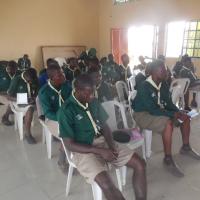
NATIONAL WOODBADGE TRAINING COURSE HOSTED BY LAGOS STATE SCOUT COUNCIL OF THE SCOUT ASSOCIATION OF NIGERIA
WOODBADGE TRAINING PROCESS:
Wood Badge is a Scouting leadership program and the related award for adult leaders in the programs of Scout Associations throughout the world. Wood Badge courses aim to make Scouters better leaders by teaching advanced leadership skills, and by creating a bond and commitment to the Scout movement.
In 1911, Baden-Powell took the first steps in training Scouting's adult leaders by organizing a series of lectures for Scouters. He made great strides in the years that followed, culminating in 1919 with the establishment of Wood Badge training. Wood Badge recipients now number more than 100,000 and can be found in all corners of the world.
Wood Badge is the advanced leadership and team-building training for adult leaders.
It teaches skills that are useful in Scouting and elsewhere
The program is for Cub Scout, Scout, Rover Scout, Explorer as well as council and district leaders.
The Objectives of Wood Badge
Wood Badge has four specific objectives: As a result of attending Wood Badge, participants will be able to:
1. View Scouting globally, as a family of interrelated, values-based programs that provide age-appropriate activities for youth.
2. Recognize the contemporary leadership concepts utilized in corporate America and leading government organizations that are relevant to our values-based movement.
3. Apply the skills they learn from their participation as a member of a successful working team.
4. Revitalize their commitment by sharing in an overall inspirational experience that helps provide Scouting with the leadership it needs to accomplish its mission on an ongoing basis.
HISTORICAL TRAINING TOPICS
Troop Organization. - Patrols formed - Practiced calls, etc. - Drill with staves - Troop formation - Patrol formation on the march (by day and night) -- Scouts' pace --Typical investiture - "Erogonyama" chorus -- -How to "break" the flag -- Camp hygiene -- physical exercises (the six from "Scouting for Boys").
Campcraft -- (a) Campsites. Selection -- Sanitation -- Fires -- Pitching and Striking camps (b) Camp expedients. – Illuminations – Kitchen Implements -- Beds and sleeping appliances -- Personal comforts -- Camp tidiness – Tent expedients -- Miscellaneous.
Pioneering. -- (a) Axemanship - Felling – Use of crosscut saw, wedges, grindstone -- Use care of knife. (b) Construction.—Rope and trestle bridge building across water -- Simple and swinging derrick -- Use of tackle.
Woodcraft. - (a) Birds and animals. -- Those found in the locality, their habits and uses -- Use of Nature notebook. (b) Trees, - How to identify them near to and far off during four seasons -- How to get the Scout keen on the subject.
Signcraft. – (a) Signaling – Hand – Whistle -- Smoke - How to teach Semaphore and Morse –Pitfalls to avoid. (b) Nature trails. (c) Sand tracking (carried out by the Chief Scout).
Games. -- (a) Scouting.—Description and actual playing of each type. (b) Camp. - Played for one hour each day.
Fieldwork. -- (a) Measurements.—Personal Distances -- Heights – Areas – River Widths. (b) Mapping. – How to read – making sketch maps. Prismatic compass – Panoramic drawing – Reports.
Study Circle Work. - (a) "Aids to Scoutmastership," (b) Headquarters "Book of Rules." (c) "Rules for Rover Scouts and Wolf Cubs," (d) "Our Aims, Methods and Needs." (e) "Sunday and the Scout."
Pathfinding. - Patrols sent out separately with sealed orders to from various points across Epping Forest, for eight-hour stretch - Leaf collecting - Report of journey - Sketch map of trek - Panoramic drawing from given point,
The first Wood Badge feast was not prepared by the course participants, but was held in London at the Scout's Club, where Everett treated them to lunch. They then enjoyed a tour of Imperial Headquarters, and a final talk the Chief Scout, who encouraged each participant to start a course in his neighborhood using Aids to Scoutmastership as a guide.
The course having been completed, it remained to find a suitable award for the participants. Baden-Powell came upon the necklace of hand-carved beads he had taken from Zulu Chief Dinizulu during the Ashanti campaign in 1888. One bead was awarded, to be worn on a leather thong pinned to the
WOODBADGE TRAINING FOCUSING ON MODERN DAY PROJECTS.
SCOUTING KNOWLEDGE: Re-examine the Mission of Scouting Application of the Scout Method: Stages of Development of young people
SCOUTING SKILLS: Campcraft, Pioneering, Orienteering, Campfire, First Aid, Unit Meeting, (as above) Short term and long term planning,
YOUTH PROGRAM. Stages of Development & Age section, Child protection, Needs & Aspiration of Young People, Developing Educational Objectives, Managing Program Cycle, Role and Responsibilities of a Unit Leader
LEADERSHIP: Counseling skill, Conflict Management Skill, Public Relation Skill, Evaluation Techniques, Problem & Decision Making Skills, Situational Leadership concept/theory, Motivation Theories & Strategies, Managing Change,
SCOUTING & THE ORGANISATIONAL ENVIRONMENT: Community Service & Development,











